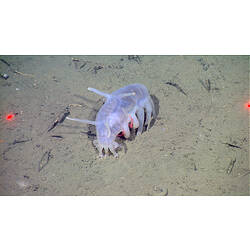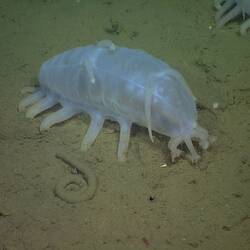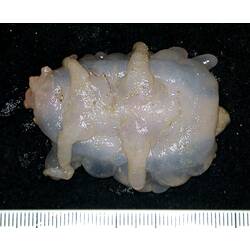General Description
Body soft, oval to approximately globular; mouth anterior terminal and slightly ventral, anus posterior sub-ventral; semi-transparent to translucent, off-white to pink/orange; 10 equal-sized tentacles with small digitate retractile processes at ends; ~5-7 pairs of prominent cylindrical tube feet for locomotion; 6 dorsal papillae, 4 long (anterior and posterior pair) and 2 rudimentary behind the posterior pair; ossicles curved 'c's and thick, spinous rods (straight); animal generally up to 15 cm long, but also recorded at up to 18 cm x 11 cm.
Biology
Scotoplanes globosa is one of several deep-sea species of sea cucumber known as a "sea pig". The pale pink, rounded animal uses its prominent tube feet to 'walk' along the seafloor, powered by water pressure and muscle contractions. Sea pigs can also be quite buoyant, passively rolling in strong currents.
Scotoplanes globosa are deposit or detrital feeders eating organic matter known as 'marine snow' which has floated down to the seafloor, often from the surface thousands of metres above. As they move across the seafloor, sea pigs use mucous-covered tentacles to transfer food from the surface layer to their mouth. This species is known to be selective in their choice of food, preferring fresh, nutrient-rich organic particles, less than 100 days old. They are known to congregate around whale falls and similar rich feeding sites, and to gather in herds facing the same direction (into the current) to detect any new fresh food sources. Their dorsal papillae are thought to potentially play a sensory 'olfaction' role, allowing them to 'sniff' the water. They often congregate in smaller groups of 10-30 but have also been seen to gather in larger groups of over 600. Populations can boom after an event such as El Niño or La Niña which can bring more nutrition from the surface to the seafloor.
The body wall of Scotoplanes globosa is usually thin and somewhat translucent, making it possible to sometimes see their gut or even deep-sea parasites including snails and small crustaceans through the body wall. Juvenile king crabs have also been recorded 'riding' or 'hiding' on this sea cucumber.
Scotoplanes globosa was first described from deep sea specimens collected from the Indian and South Pacific Oceans on the historic voyage of the H.M.S. Challenger in the late 1800s and has since been found in almost all deep-sea regions in the world, typically living at depths of over 1000 m, on abyssal plains and at hadal depths including in deep-sea trenches. On the Sampling the Abyss expedition this species was found in the Freycinet Commonwealth Marine Reserve off Tasmania at a depth of just under 3000 m. It is likely that Scotoplanes globosa as currently recorded is a complex of species.
Distribution
Worldwide. Almost cosmopolitan, but not yet known from the North Atlantic. Abyssal to hadal depths including deep-sea trenches, ~2100 -6770m. In Australia currently recorded from deep sea off Tasmania.
Habitat
Deep sea marine species occurring worldwide at abyssal and hadal depths, including deep sea trenches, ~2100 -6770 m.
More Information
-
Animal Type
-
Animal SubType
-
Fast Fact
Sea pigs 'walk' very slowly along the seafloor on their prominent tube feet and have been seen giving juvenile crabs a ride.
-
Brief Id
Soft, rounded body; translucent off-white to pink/orange; ventral feeding tentacles; dorsal papillae; prominent ventral tube feet for locomotion.
-
Colours
Pink, Orange, Cream
-
Maximum Size
18 cm
-
Habitats
-
Diet
Organic matter
-
Endemicity
-
Depths
Deep ( > 30 m)
-
Water Column Locations
On or near seafloor
-
Taxon Name
-
Scientific Author
(Théel, 1879)
-
Common Name
sea pig
-
Other Names
Sea Cucumber
-
Phylum
-
Class
-
Order
-
Family
-
Genus
-
Species Name
globosa






